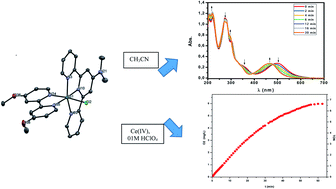New ruthenium polypyridyl complexes as potential sensors of acetonitrile and catalysts for water oxidation†
Abstract
New ruthenium(II) polypyridyl complexes of formulae [RuCl(Me2Ntrpy)(bpy-OMe)]Cl, 1, and [Ru(Me2Ntrpy)(bpy-OMe)(OH2)](CF3SO3)2, 2, with Me2Ntrpy = 4′-N,N-dimethylamino-2,2′:6′,2′′-terpyridine and bpy-OMe = 4,4′-dimethoxy-2,2′-bipyridine, were synthetized and characterized by spectroscopic and electrochemical techniques. Besides, [Ru(Me2Ntrpy)(bpy-OMe)(NCCH3)]2+, 3, was obtained and characterized by UV-vis spectroscopy in acetonitrile solution. All experimental results were complemented with DFT and TD-DFT calculations. The complete structure of complex 1 was determined by X-ray diffraction, evidencing that the Ru–N and Ru–Cl bond lengths are longer than those determined in [RuCl(trpy)(bpy)](PF6). The strong electron donating properties of the substituents of both bpy and trpy rings in complexes 1 and 2 led to their potential applications for detecting traces of acetonitrile as a contaminant in aqueous solutions of radiopharmaceuticals and to utilization of complex 2 as a promising candidate for catalyzing water oxidation processes.



 Please wait while we load your content...
Please wait while we load your content...